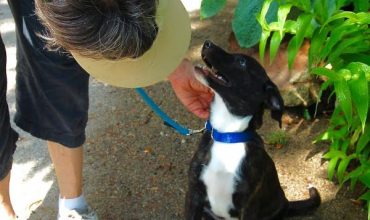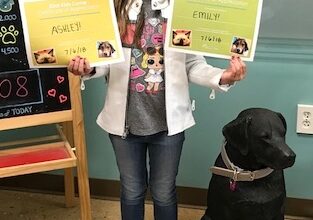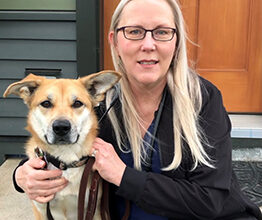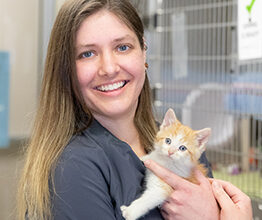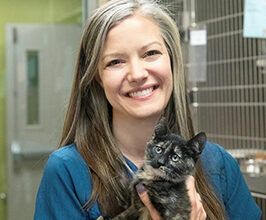I’ve been wanting to adopt a puppy for some years, and was waiting for the best time. It has come, and so has the “Love Train” with this little sweetie on board. Oracle now Shanti
Read More
Posts by Wendy Welch
Extra Help for HSHV Animals!
Emily and Ashley are an animal lovers who know that the animals in their community could use some extra help. Both girls decided that a great way to help out would be to hold a lemonade stand and donate the proceeds to HSHV. We are so grateful for her hard work and were so happy that they support our organization. Thank you to Emily and Ashley for showing so much compassion!
Read More
Does your pet need sunscreen?
[print-me] This is a common question many ask themselves this time of the year! Animals, just like humans, are at risk for sunburn and skin cancer with overexposure to the suns UV rays. The best way to minimize UV exposure in pets is to avoid the sun between 10 a.m. and 4 p.m., when the sun’s rays are strongest, by keeping the pet inside or in a shaded area. If that is not possible, sunscreen can be applied to protect their skin. Pets with light skin or fur and a short or thin hair coat are particularly at risk, or
Read More
Completing our HSHV Pack
I started volunteering at HSHV in October of 2016 after losing my first fur-baby to lymphoma a few months before. Three weeks later, I met my first HSHV alum, Dobby, and fell head over heels the moment I saw him. At the time, we were living with my parents and their puppy, but in the summer of 2017 Dobby and I were able to get a home of our own. I had planned on getting Dobby a sibling when my work settled down a bit, but it soon became apparent that he needed another dog around sooner rather than later.
Read More
Robin Berry, DVM
Outpatient Veterinarian Companion Animals – Michigan State University Dr. Robin Berry is a 1995 graduate of the College of Veterinary Medicine at Michigan State University. A longtime Ann Arbor resident, Dr. Berry was born in Ypsilanti and lived in a house on Cherry Hill Road before her family relocated. She grew up in Troy and moved to Ann Arbor to attend U of M, graduating with a degree in English. She worked for three years as an editor of engineering, environmental science and medical books and journals before pursuing her lifelong dream of becoming a veterinarian. Right out of school,
Read More
Sarah Carter, DVM
Outpatient Veterinarian Companion Animals – Michigan State University After receiving her DVM from Michigan State University, Dr. Sarah Carter completed a one year rotating internship in Rhode Island with a focus on emergency medicine. She’s had a lifelong passion working with, and caring for companion animals and exotic/pocket pets. Her interests stemmed at early age caring for her own pets, undergoing training to become a licensed veterinary technician, working as a technician primarily in emergency medicine, training and fostering assistance dogs, and voluntarily fundraising for Assistance Dogs of America and helping educate the public regarding working dogs and emergency medicine.
Read More
Courtney White, DVM
VP of Veterinary Medicine Cats, Dogs, and Small Domestics – Michigan State University Dr. Courtney completed her undergraduate career at Michigan State University and went on to earn her Doctorate of Veterinary Medicine at the Michigan State University College of Veterinary Medicine. Following graduation, she completed an internship at Michigan Veterinary Specialists and later trained at the University of Tennessee College of Veterinary Medicine where she received her certification in canine physical therapy. Outside of work, Dr. Courtney enjoys spending time with her three children, hiking, camping, fishing, going up north. Her family has two dogs and a cat who have all
Read More
After Surgery Instructions
[print-me] Going Home: Rest is important for your pet tonight. Please take him or her home to a warm, quiet, dark, comfortable place where your pet can get some sleep. (Please keep any other animals away, even if they are pals.) Side Effects: The first day after surgery, your pet may act peculiar. Mostly, your pet will want to sleep, but he or she may cry, shake, drool, or be uncoordinated. This behavior can be normal for the first few days, but your pet should be back to acting like itself soon after that. If your pet appears in pain, call the
Read More
Before Surgery Instructions
You must have an appointment. Please call (734) 662-4365 to schedule an appointment. We recommend that you have your pet vaccinated for rabies and distemper. All animals are required to be current on rabies and distemper vaccines. If not, vaccines will be updated at time of surgery. Please bring vaccine history with you at the time of your appointment. All adult animals must have food withdrawn the night before surgery at 12:00 midnight. Animals 4 months or younger may have food until 6:00 a.m. the morning of surgery. Check-in time is at 8:00 a.m. prompt. Doors open at 8:00 a.m.. If
Read More
Top 10 Reasons to Spay or Neuter Your Pet
[print-me] Adapted from the ASPCA Your female dog or cat will live a longer, healthier life.Spaying—the removal of the ovaries and uterus—is a veterinary procedure performed under general anesthesia that usually requires minimal hospitalization. Spaying a female cat or dog helps prevent pyometra (pus-filled uterus) and breast cancer. Treatment of pyometra requires hospitalization, intravenous fluids and antibiotics. Breast cancer can be fatal in about 50 percent of female dogs and in 90 percent of female cats. Spaying your pet before her first heat offers the best protection from these diseases. There are major health benefits for your male animal companion, too.Besides
Read More




